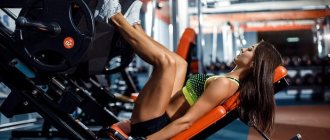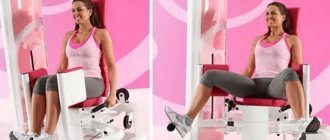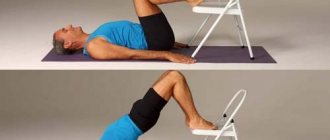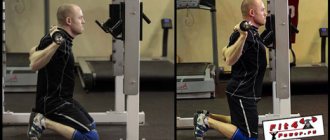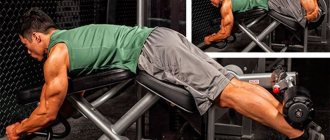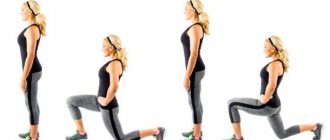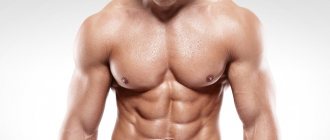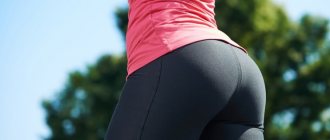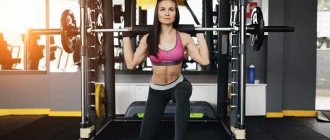Author: Timko Ilya - the ruler of the entire site and fitness trainer | more details >> Rod. 1984 Trained since 1999 Trained since 2007. Author and creator of the site tvoytrener.com. CCM in powerlifting. Champion of Russia and South Russia according to AWPC. Champion of the Krasnodar region according to IPF. 1st category in weightlifting. 2-time winner of the Krasnodar Territory championship in t/a. Author of more than 700 articles on fitness and amateur athletics. Author and co-author of 5 books.
Place in the author rating:
out of competition
(become an author) Date: 2012-05-29 Views: 908,428 Rating: 5.0
| All articles by the author >> | Medals articles >> |
Articles are loading...
| Article medals: | article in TOP 100 | more than 500 thousand views |
Why medals are given to articles:
| Bronze medal: | |
| 1. The article is in the TOP 100 2. The article has more than 3. The article has more than 100 | |
| Silver medal: | |
| 1. The article is in the TOP 50 2. The article has more than 3. The article has more than 500 | |
| Gold medal: | |
| 1. The article is in the TOP 10 2. The article has more than 1 3. The article has more than 1,000 | |
Primary muscles - quadriceps femoris Additional - none Difficulty - easy
What muscles are used by leg extension in the machine?
This is a very large muscle group, containing 4 separate heads. Hence its name. From Latin “quadro” is translated as four. Its more scientific name is the quadriceps femoris muscle.
Each head of the quadriceps has its own name.
- Rectus muscle (head). Is the largest of the 4 heads. Located almost in the center of the thigh. It is superficial, therefore, with good development of this head, we can clearly see it. It is this that will give volume to the quadriceps, that is, its thickness. Its main functions include: extension of the lower leg (leg) and flexion of the hip (for example, when we sit down). Receives most of the load at the beginning of the movement.
- Vastus medialis muscle. It is a much smaller muscle. Located just above the knee, closer to the inside. Its shape resembles a drop of water. Responsible for leg extension.
- Vastus lateralis muscles. Located on the front surface of the thigh closer to the outer edge. Responsible for the extension and rotation of the legs outward. That is, feet apart.
- Vastus intermedius muscle. This head is located under the rectus muscle. Also responsible for leg extension and hip flexion. Its good development will begin to push the rectus muscle upward, thereby visually making your hips more massive.
All of these muscles attach to the femur and are one of the stabilizers of the legs and knee.
It is also possible to identify some assistant muscles that receive indirect load and serve more to stabilize the position of our body.
- Back muscles
- Hand
- Press
They work in static voltage.
What can replace the exercise?
If your knees hurt as a result of the impact on the tendons and ligaments surrounding the kneecap, you need to look for an alternative to the exercise. For men, deadlifts, squats, and leg presses are good options. As for girls, the barbell can be replaced with a barbell weighing 5-10 kg. Also a good alternative would be lunges and squats, which will work not only the quadriceps, but also the buttock muscles.
Watch a video on how to perform deadlifts correctly.
As you can see, the exercise is completely simple to perform, but can be traumatic for people with problems with knee joints. You need to start working with the simulator carefully in order to understand the body’s reaction. If there are no painful sensations, you can gradually increase the weight of the weight.
Advantages and disadvantages of this exercise
It may seem that since the exercise is popular and many people recommend it, then it should have only advantages. Yes, I agree they exist and this:
- The ability to detail the quadriceps and give them an expressive shape.
- An opportunity to finish off your quadriceps if you no longer have the strength to do heavy basic exercises.
- With the correct technique, extension can strengthen the knee ligaments.
- And of course, it provides isolated work on all 4 quadriceps muscles.
But in addition to all these advantages, you must take into account that this exercise is extremely dangerous for your knees! Cruciate ligaments are especially at risk
.
They prevent the knee joint from moving forward and backward, as well as in and out. That is, during strong extension of the knee with a fixed pelvis (which is what happens in this exercise), these ligaments are very stretched. Or rather, one of them is the front one. This may lead to its rupture. Yes, it can be treated, but for me it’s not worth it. And after such an operation, you are unlikely to be able to continue your training with the same intensity. Especially for beginners, doing this exercise does not make any sense. After all, you can’t build muscle mass with extensions! Why am I telling you all this? Because it is very important to me that you have an understanding and are aware of all the risks before you start doing leg extensions in the machine. And knowing this, you will already decide whether it is worth exposing your knees to such danger.
But still, exercise can bring not only injuries, but also benefits. The main thing is to know when to do it and avoid making serious mistakes. The most important thing is to do everything with the right technique.
Essence and basic principles
Leg extension in the simulator allows you to create a load specifically on the quadriceps, and this is one of the largest muscles in the human body and its main function is to extend the knee joint and straighten the limb. It is this muscle that is partially involved in flexion of the hip joint. The exercise machine is a regular horizontal bench, divided into two parts.
One of them is a chair, and the second is a backrest. The most useful element in this design is the corner, which is fixed to the horizontal edge of the bench. Directly attached to it are structural parts with side fasteners (left and right), covered with soft material. This machine allows you to perform leg flexion and extension while sitting or lying down.
Benefits of leg extension using a machine:
- It is possible to work out all parts of the quadriceps in a targeted and isolated manner.
- It is possible to achieve serious increases in the strength of the reed muscles.
- The relief improves significantly, the muscles become more clearly defined on the body.
- Ligaments are strengthened.
- Increases endurance.
- Performance improves when performing basic exercises.
Professional athletes say that without leg extensions on the machine, the workout would not be complete. This set of exercises helps you warm up before the main workout, and after exercise you can also do some follow-up work, working each muscle well with maximum weight. The main thing is not to be lazy, do 3-4 sets of 20 times, for beginners you can do 10 times and increase with each workout.
Execution technique
From the outside it may seem that the exercise is very easy to perform. I sat down on the exercise machine and began to straighten and bend my legs. But unfortunately, it only seems so. There are technical issues and subtleties that must be taken into account. And before you start the exercise. We will need to customize the simulator for ourselves.
Initial position:
The leg extension machine resembles a chair. It has an adjustable backrest that moves forward and backward. Special soft cushion for feet. It is also adjustable, thereby rising higher or lower. To ensure that the pelvis does not come off the seat, there are handles on the sides. Which you have to hold on to with your hands. The system for installing weights varies. From barbells to special blocks.
- Go to the leg extension machine. Set the weight you need by hanging weights or setting the limiter to the desired number of blocks.
- Adjust the backrest so that your thigh rests completely on the seat. And the knee went slightly beyond the edge of the seat.
- Place your feet under the bolster. It must be adjusted so that it is located in the lower part of the lower leg, in the area of the ankle joint. In this case, your legs should be bent at an angle of 90° or a little stronger.
- Next, straighten your back and bring your shoulder blades together. We rest against the back and grab the handles with our hands.
Important!
The knee should not have an acute angle when bending. This will only increase the load on the joints. And there will be a risk of injury!
Performance:
- After taking the starting position, while exhaling, straighten your legs at the knee joint.
- Do not pause at the top point. As you inhale, bend your legs to the starting position.
Why I don’t recommend staying in the top position. It all comes back to keeping your knees healthy. Yes, if we take a short pause at the top, our quadriceps will receive a greater load. But it will also affect the joints. Therefore, you should choose health or efficiency.
Adviсe
- Various sports doctors say that leg extensions put excessive stress on the knee joints. To reduce this stress as much as possible, do not allow your shins to slide under your hips—at the bottom of the exercise, your knee angle should range from 90 to 100 degrees.
- At the top of the exercise, always extend your legs as much as possible - this is the only way to achieve better contraction of the external lateral and internal medial muscles, which are responsible for fixing the kneecap.
- Do not take too much weight - it can clog your knee joints and, in addition, will not allow you to fully straighten your legs. The load on the quadriceps muscles in leg extensions is best achieved with an additional number of repetitions, rather than with heavy weights.
- If tight muscles in the back of your thighs prevent you from straightening your legs as much as possible, in the starting position, slightly tilt your body, while moving the back of the machine slightly back to an angle of 45 degrees, then secure the seat parallel to the floor. This will not only soften the tension in the hamstring muscles, but will also give you a great stretch for the main leg muscles - the quadriceps. Do not lean your torso forward - this will reduce the effectiveness of the exercise.
- To concentrate the load on the middle part of the quadriceps, spread your toes apart. If you want to hit the outer lateral quadriceps muscles hard, move your toes slightly inward.
- If you feel that this exercise puts a lot of stress on your knee joints, change it to leg extensions in a block machine. Secure the cable strap that runs through the lower block to your right ankle. Place your emphasis on your left leg while you stand with your back to the block, and bend your right leg slightly at the knee and slightly lift it. Keeping your torso and hips still, complete all repetitions of left leg extensions. Then fix the strap to your right leg and perform all repetitions for the second leg.
Leg extension - errors in the exercise
Recommendations for implementation
There are several simple techniques that will help you load the quadruple major thigh muscles in a new way. It's about:
- Full and partial amplitude. If we fully extend the leg, then the load falls more on the broad medial head. But if we work with a little more weight in a partial amplitude. That is, extend your leg halfway. Then the direct and intermediate heads will be involved in the work. When using partial amplitude, you will need to tilt the back slightly back. This will stretch these heads more.
- Turning the feet. The position of our legs also determines which head will receive the most load. If you turn your feet inward towards each other. This will stretch the lateral head more, and it will be used more than the others. Turning your toes to the sides will shift the emphasis to the medial head.
- One leg extension. This is a more professional technique; beginners do not need it. Performing an extension with one leg, it is easier to focus on the work of the hip. Also, using this exercise, you can reduce the imbalance in the development of the quadriceps of each leg.
You can try each of these techniques. The main criterion should be the correct execution technique. So work on it before making these kinds of changes to the exercise.
Technique for performing single leg extensions in the simulator
If you have very noticeable asymmetry of the thigh muscles or have had an injury to one leg, you can perform this exercise with one leg. To increase the load, you can also do extensions alternately.
- Having adjusted all the necessary elements of the simulator, we take a comfortable position with a straight back.
- We place our foot under the bolster. If the machine has separate leg supports, we simply work with one leg. If there is only one roller, then you should move your foot to the center.
- As you exhale, extend your leg until your knees are straight. We hold the position for 1–2 seconds, after which we smoothly lower it down.
- Either we change the leg, or we repeat the required number of times.
If you do not have the appropriate indications, it is still undesirable to do the exercise on only one leg. You can do different numbers of sets and use different weights for each leg, but still work both.
Basic mistakes
Too much weight
I will not tire of repeating that this mistake applies to any exercise. But it is the isolated who bear the greatest risk. And if we take on weight that we can't handle. Then the resulting injury is all that shines for us. And I already said that straightening the legs can cause rupture of the knee tendons. This will lead to complete refusal of training. But this is not the worst thing. You may remain crippled for life, confined to a wheelchair. I don’t see the point of doing this exercise with heavy weights, since it has no effect on muscle growth. Therefore, you can safely work in multi-repetitive mode. And use light weight.
Jerking movements
I think everything is clear here. Jerking movements occur when you are unable to cope with weight. And I have already written about the consequences above. Your main task is to ensure control over your weight and your movements. Feel the thigh muscles contract and stretch.
Errors during execution
The seated leg extension machine allows you to perform the exercise technically correctly. But even in this case, some gym goers manage to make gross mistakes that harm their health.
Excessively heavy weight
This is the most common mistake among men. Seated leg extensions are an isolation movement that are not designed to handle heavy weights.
As soon as excessive weights begin to be used, additional muscles are connected to the movement, which is unacceptable and absolutely meaningless for an exercise of this kind.
In addition, with this approach, the entire load falls on the knee joint, greatly overloading it. Over time, this inevitably leads to injury.
The weight in seated extensions should be optimal, not the maximum possible.
Fast pace of execution
This error is closely related to the previous one. When using excessively heavy weights, the practitioner does not have the strength to do the exercise slowly and under control.
To cope with an unbearable load, extension is done with a jerking upward movement, and downwards the weight practically falls.
Despite the weight installed on the block, the load on the quadriceps is minimal in this case.
Most of the movement is accomplished through inertia and the use of additional muscles.
The other extreme is a weight that is too light and floats up and down. In this situation, the movement is also performed quickly. But the weight of the burden is extremely small for the muscles to work out at least somehow.
Lowering the legs too low and relaxing the quadriceps
If the first two errors lie on the surface and are striking, then this one is not so noticeable. However, it also leads to a decrease in the effectiveness of the exercise.
When lowering your legs, they are brought too far back, under you. In this position, the quadriceps no longer work. But the point of the exercise is constant muscle tension in the quadriceps, from the first to the last repetition in the approach.
For this purpose, you should not lower your legs too much until the muscles relax. On the contrary, in the bottom position the legs do not even go down to 90° between the shin and thigh.
This creates constant tension in the muscles in both the upper and lower positions.
Inclusion in the training program
This exercise is mainly used in several cases:
- As a supplement at the end of a leg workout to get the most out of your quadriceps.
- As a warm-up before leg training. In this case, a small weight is used, purely to warm up the quadriceps.
- And before performing a basic exercise, in order to tire the muscle and then push it with more weight.
In each of these options, preference is given to a large number of repetitions from 15 to 20. Mostly 3-4 approaches are used.
My personal recommendation is not to use this exercise on an ongoing basis. If you can do without it, then feel free to replace it with something more effective and less dangerous. And most importantly, don’t forget about technology. Take care of your knees!
Good luck to everyone in your training!
Basic set of exercises
Beginners in sports, when they see a simulator, may think that they will definitely not be able to do all the exercises the first time. But it's not quite like that. If you follow the instructions, then after the first exercise you can feel that all the leg muscles are well worked out. As mentioned earlier, before you start working with it, you need to set the simulator to your personal parameters.
Adjust the backrest, position of the bolsters and weight:
- The backrest is installed so that the thigh rests completely on the seat. The knees rest on its edge, and the sacrum is pressed against the back.
- The second roller, behind which the legs will be wound, must be installed so that the lower part of the shin rests against it. The knee should be bent 90 degrees.
- Set the weight. It depends on the level of training. You need to set the weight so that it is convenient to do 3-4 approaches, each 15-20 times. Gradually it will be possible to increase the weight with each new workout, but only slowly.
When the simulator is set up, you can begin performing a set of exercises:
- Sit on the machine, your back should be pressed tightly against the machine, and your legs should be placed behind the roller. Place your hands around the special handles on the sides of the machine. Raise your toes up.
- Exhale and straighten your knees. At this moment, tense the thigh muscles at their highest point as much as possible and hold for 2 seconds.
- As you exhale, lower your legs down, but do not bend them all the way. The muscles in the lower thigh should be tense. It is imperative to monitor the sensations in the knee joint, and do not lower your legs down suddenly.
- Repeat this exercise several times.
You can also perform the exercise accurately, but only with each leg separately. This approach allows you to better feel the work of the muscles. It can also be used by athletes who have asymmetry. You can perform the same exercise, but only when straightening your legs, turn your toes in different directions, thereby straining the inner or outer thigh muscles.
There are also machines that allow you to do leg extensions while lying on your stomach. This complex allows you to pump the upper and lower thigh areas. To enhance the effect, experienced trainers advise spreading your toes to the sides.
You need to do the exercise like this:
- The back of the exercise machine must be reclined as far as possible so that you can comfortably lie down on it, face down. The waist should be located on the line that separates the top of the seat from the bottom.
- Place your shins behind the bolsters, and grab the handles located on the sides with your hands.
- Using your biceps, bend your knees and bring the weight to the buttocks. At the most critical point, pause for 2 seconds and slowly lower your legs to the starting position.
- While performing the exercise, in a lying position, your knees should not be fully straightened; the rollers should be kept suspended throughout the entire workout.
You can also perform exercises with the machine in a standing position:
- You need to stand facing the machine, rest the ankle of one of your legs on the roller, and the other on the floor. Be sure to ensure that your hips are flush against the back of the machine.
- Hold the handles, exhaling deeply, bend your working leg and lift your foot up as high as possible until the roller touches your thigh.
- As you exhale, you need to return to the starting position, but do not fully extend the limb, moving into the positive phase.
If the gym does not have a special machine designed for leg extension, then you can diversify the program and perform a special complex on the crossover at its lower block.
And you can do it like this:
- Place a cuff on the ankle, which is fixed to the cable of the lower block.
- Stand up straight and grab the handles of the crossover with your hands, if they are provided in it, of course.
- After exhaling, bend your leg, which is attached to the equipment with a cuff. Stay in this position for 2 seconds.
- Inhale and return to the starting position, but do it slowly, controlling your movements and feeling how strongly the muscles located at the back of the thigh are tense. The knee remains motionless at this time; under no circumstances should it be moved to the sides, forward or backward.
If you don’t have a machine, you can easily replace it with a regular bench and dumbbell.
The exercise in this case is performed as follows:
- Lie on a bench with your knees hanging slightly.
- Hold the dumbbell between your feet.
- Grasp the edge of the bench with your hands.
- While exhaling, bend your legs at the knee joint, while the biceps should become very tense.
- Then return to the starting position, but do not fully extend your legs.
When you already feel that the muscles are very tired, when extending the lower leg to full amplitude, you can perform another approach with several repetitions with partial amplitude. The main thing is not to throw weight, but to do everything smoothly.
In order for the muscles to work harmoniously and a beautiful relief to be drawn, it is imperative to complement the leg extension exercise with other exercises designed to train the muscles of the back of the thigh. If the knee joints hurt as a result of the fact that the exercise actively affects the ligaments and tendons, then in this case you will need to find an alternative.
For the stronger half of humanity, a suitable option is deadlift, squats with a barbell, leg presses. But as for the fair half, they can take not a barbell, but a bar weighing 5-10 kg. A very good alternative is simply lunges or squats, thanks to which you can not only perfectly work all 4 thigh muscles, but also the gluteal muscles.
Don’t miss the most popular article in the section: Glutamic acid - what it is, why and how it is used in sports and bodybuilding.
Seated leg extension. What, why and why?
Almost every gym, even the most shabby and mossy, has a machine for seated leg extensions. And, of course, if it exists, then exercises are performed on it, and it enjoys a certain popularity. Well, if so, then you and I have food for thought regarding how to use it correctly. You say: what can I do there, I sat down and went to stretch my legs. And you will be right, but only partly, because everyone who attends strives to bring something of their own to leg extension. In order to understand whether some kind of gag is needed here and how to generally use this extension iron machine in leg training, we will talk in this article.
We recommend reading: How to replace protein and sports nutrition
Note: For better assimilation of the material, all further narration will be divided into subchapters.
Muscle atlas
Seated leg extension is an isolation exercise aimed exclusively at developing the muscles of the front of the thigh - the quadriceps. There is no need to maintain balance, and for this reason, stabilizer muscles are not involved in the work. The machine itself has a seat with a backrest to support the spine, which makes it safe for those who have back problems. The machine also has a specific, predetermined trajectory of movement, which reduces the risk of injury from loss of control or falling weight.
The main working muscles are:
- targeted – quadriceps femoris muscle;
- stabilizers - trapezius (top/middle), levator scapulae, biceps, brachialis and brachioradialis muscles.
The complete muscle atlas looks like this:
The quadriceps has 4 heads, i.e. consists of four independent muscles: the rectus muscle is the longest biceps muscle, which stretches from the pelvis to the kneecap. She flexes the thigh at the hip and extends the lower leg at the knee joint. Under the straight line lies the intermediate wide one, which pushes it outward during hypertrophy. On the sides of the thigh are the vastus muscles of the thigh - medial and lateral. To achieve teardrop-shaped thighs, you need to have well-pumped “outside” thigh muscles.
When performing the exercise, the knee joint is extended, as a result of which the lower leg is moved away from the thigh. The rectus and intermedius muscles of the quadriceps are responsible for this movement. To increase the efficiency of the movement, it is necessary to “tighten” these two muscles by tilting the body back. The medial and lateral muscles complete the extension movement.
Advantages
To a certain extent, the exercise is ambiguous, and later you will understand why. The benefits obtained from doing it include:
We recommend reading: How to burn fat on a woman’s stomach and sides quickly: ways to get rid of extra centimeters and lose weight
- isolated and accentuated work of the quadriceps;
- development of hip strength;
- provide good detail, “banding” of the muscles of the front of the thigh (division into fibers, separation);
- strengthening the patella ligaments;
- improving performance/results in other sports - football, hurdles, long and high jumps;
- increasing working weights in “leg” exercises (squats, leg press);
- used as a rehabilitation exercise after knee injuries;
- ease of implementation.
As you can see, there are quite a sufficient number of advantages for such a simple exercise.
Execution technique
Despite all the fitness of the exercise, it requires compliance with clear instructions. The step-by-step technique for performing seated leg extensions is as follows.
Step #0
Go to the extension machine and set the working weight. Place your “wife” deeply in the seat, place your feet under the bolster and grab the side handles with your hands. This will be your starting position.
Step #1
Inhale, as you exhale, using the strength of your quadriceps, straighten your legs as much as possible. Hold for 1-2 counts in the compressed position and then slowly return the projectile to the IP. Repeat the specified number of times.
In the picture version, all this disgrace looks like this:
Note:
We recommend reading: Exclusive interview; Interview with the champion: Ivanna Krupenya
The optimal extension machine is one with a seat parallel to the floor. In this position, the hamstrings do not interfere with the full extension of the quadriceps, and this is extremely important for their stimulation.
Variations
In addition to the classics, there are the following variations of the sitting leg extension exercise:
- alternately sitting with one leg;
- alternately with one leg half standing.
By the way, the last option is very exotic and is used extremely rarely.
Few people know, much less apply, different positions of the toes when performing extensions. In total, there are three positions that are designed to solve different problems:
- classic - straight toes, general development of quadriceps;
- toes out - heels together, toes apart, emphasis on the inner thigh;
- socks inward - emphasis on the lateral/medial part of the quadriceps, the outer surface of the thigh;
A technically simplified, but even more effective option due to the “unloading” of the knee joint and putting more stress on the quadriceps, is the following exercise. Attach a cable from the lower block to your ankle, bend your leg at the hip to an angle of 45 degrees, without changing the angle, straighten your leg.
Calculate your ideal sports weight!
Secrets and subtleties of implementation
Despite all its simplicity, it is necessary to remember the following technical features:
- adjust the position (height) of the rollers - they should fall on the bottom of the lower leg muscles ( 8-10 cm above the feet), and not the instep of the foot;
- make sure that the angle between the bottom and top of the legs is 90 degrees (i.e., the knee should not extend beyond the toes);
- Make sure that your feet are not tucked under the seat when starting;
- To reduce the stress on your knees when lowering the weight, do not put your shin under the seat;
- do not hang at the bottom point and do not bend your legs completely, leaving the load on the quadriceps;
- hold the peak contraction for 1-2 seconds at the top point of the trajectory;
- Every time you rise, strain your feet and pull your toes towards you - this will force the vastus medialis muscle to contract as much as possible;
- press your back firmly against the support of the bench seat;
- your back thigh should rest completely on the bench, so keep an eye on it and don't let your knees droop;
- firmly secure yourself in the “saddle” and do not move your body while performing the exercise;
- use extensions at the end of leg training as a finisher with a high number of repetitions 10-15;
- at an advanced level, you can use extensions as a pre-exhaustion and then do the main leg training.
Leg extensions: bad for my knees?
To a certain extent, we can say that yes, especially for the fair sex, and “women are in favor”... The thing is that the anatomically surrounding ligaments and tendons of the knee areas in women are much weaker than in men. And therefore, any deviation of the weight load from the norm can lead to knee injuries. These standards are different for each fitness person, so when “saddled” with a leg extension machine, you must remember to gradually “step” increase the weight and read the knee feedback after completing the approach.
In general, when performing seated leg extensions, there is constant tension on the anterior cruciate ligament. There is also an increased risk of lateral deviation of the kneecap and increased stress against shear forces. Doing leg extensions on a machine with heavy weights dramatically increases the likelihood of knee injury due to the forces involved. Remember that when the quadriceps muscle is stronger than the hamstrings (especially in women), the knee loses stability and the risk of injury increases, so you also need to pump the back thigh and not “run” it.
Well, that’s all I’d like to talk about, let’s summarize this chatter.

